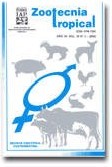
|
Zootecnia Tropical
Instituto Nacional de Investigaciones Agrícolas Venezuela
ISSN: 0798-7269
Vol. 27, No. 4, 2009, pp. 383-391
|
 Bioline Code: zt09041
Bioline Code: zt09041
Full paper language: English
Document type: Research Article
Document available free of charge
|
|
|
Zootecnia Tropical, Vol. 27, No. 4, 2009, pp. 383-391
| es |
Factores no genéticos que afectan el peso al destete en vacunos Brahmán registrados
Rodríguez, Yhoangel; Martínez G., Gonzalo & Galíndez G., Rafael
Resumen
Para determinar como influyen algunos factores no genéticos sobre el peso al destete (PD) ajustado a 205 días
(P205), se analizaron 3.221 pesos de becerros Brahman. Todos los animales se encontraban a pastoreo, bajo
manejo sanitario adecuado a las condiciones de cada hato. Los datos fueron estudiados a través de un análisis de
varianza por la metodología de máxima verosimilitud restringida con un modelo que incluyó los efectos fijos:
hato (H; 1-4); año de nacimiento (AN; 1996-2004), época de nacimiento (EN; Seca y Lluviosa), edad de la madre
al parto (EM; 3,...,10 ó más años), sexo (S; Machos y Hembras) y las interacciones HxAN, HxEN, HxS, ANxEN
y ANxEM. Todos los efectos resultaron altamente significativos (P < 0,01), con la excepción EN. El promedio
de P205 fue 190,94 kg (et = 1,78 kg); la diferencia entre hatos extremos fue de 34,13 kg y la divergencia entre
el mejor (2002) y peor año (2003) fue 24,72 kg. Vacas de 3 y 10 ó más años destetaron en promedio becerros 10
kg menos pesados que vacas con edades entre 4 y 9 años. Becerros machos fueron 14,20 kg más pesados. Las
interacciones con H indican que la dirección y magnitud del efecto estos no son constantes dentro de cada H.
El P205 es afectado por todos los factores no genéticos estudiados, pero no fue afectado por la EN, aunque sin
embargo, si existió diferencias entre épocas dentro de H y AN, debido a la interacción entre EN con estos factores.
Palabras-clave
ganado de carne, factores ambientales, crecimiento predestete.
|
| |
| en |
Non-genetic factors affecting weaning weight in registered Brahman cattle.
Rodríguez, Yhoangel; Martínez G., Gonzalo & Galíndez G., Rafael
Abstract
To determine the influence of some non-genetic factors on weaning weight adjusted at 205d (P205) of Brahman
registered cattle, 3221 weights were analyzed. All the animals were grazing and under sanitary managing adapted
to the conditions of every herd. The data was analyzed using an analysis of variance under restricted maximum
likelihood methodology and the statistical model included: herd (H; 1-4), year of birth (AN; 1996-2004), season
of birth (EN; Dry and Rainy), age of the mother at calving (EM; 3-10 ó more years) and sex (S; Males and
Females) and the interactions HxAN, HxEN, HxS, ANxEN and ANxEM. All effects and the interactions affected
P205 (P<0,01), with the exception of EN (P<0,05). The average P205 was 190,94 kg (standard error = 1,78
kg). Important differences existed among herds, being 34,13 kg for extreme herds. The differences between the
best years (2002) and worse year (2003) was of 24,74 kg. Cows of 3 and 10 ó more years had in average calves
10 kg less heavy than cows from 4 to 9 years of age. Males calves weighed 14,20 kg more than females. The
interactions that involved H indicate that the direction and magnitude of the effects are not constant within every
herd. The P205 is affected by all the environmental factors studied, but it was not affected by EN, although, it
existed differences between EN inside H and AN, due to the interaction between EN and those factors.
Keywords
beef cattle, environmental factors, preweaning growth.
|
| |
© Copyright 2009 - Zootecnia Tropical
Alternative site location: http://www.sian.inia.gob.ve/repositorio/revistas_ci/ZootecniaTropical/ztindice.htm
|
|
